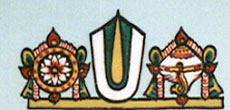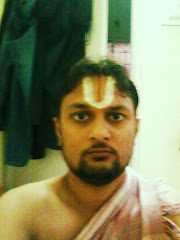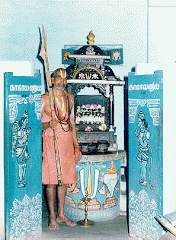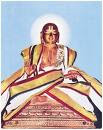bhagavan shri bhashyakara , in his famous work vedartha samgraha , enlightens the meaning of the famous words " tath tvam asi" using unprecendented logic called samana adikaranya meaning coordinate predication. this principle can be explained with a simple example.
the mayavadin points out that in the cognition such as a purple rope, red rope etc, the rope alone is real and color is unreal. Ramanuja says that in explaning the term a purple or red rope the relationship between color and substance is {aprtak siddhi meaning inseparable} yet different. he says reduction or nullifying the attributes of a substance doesnt yield the nature of real substance. the substance has to be understood as a whole including attributes and the relationship between them. this is called as samana adikarnya. it necessitates that the attributes are different from each other and from the substance yet inseperable. like the purple and long lope, the color and size are different from eachother and from the rope but are inseperable.
the same way he explains the passage "tath tvam asi" meaning the Brahmam is the bastion where jeevatmas reside and they are his modes , inseparable yet different and this forms a whole {brahmam} but qualified by different atributes and expressions like prakriti , jeevatmas and his vishesha attributes like satyam jnayam, anantham, anandam, salubyam, aishwaryam etc.
from logical point of view , Ramanuja's use of samanadikaryna surpasses all the levels of excellence for it give a unitary view of upanishads and solves the conflict between passages conveying bedha and those conveying abedha.
Saturday, November 24, 2007
Wednesday, November 21, 2007
A TRIBUTE TO SRI GOVINDA SESHAN{MATERNAL PITHAMAH}
SHRI GOVINDA SESHAN , ADIYENS MATERNAL PITHAMAH, WAS A SIMPLE MAN WHO LAID EMPHASIS ON KARMA AND DISCIPLINE. RETIRED AFTER BEING A DEPUTY COLLECTOR AND LATER AS MANAGING DIRECTOR OF TAMCOF AND AAVIN, HE WAS A STERN DISCIPLINARIAN WHO WANTED PERFECTION IN ACTION. HE WAS A TIVRA ACHARYA BAKTHA AND SHOWED US IN ACTION THAT ACHARYA BHAKTI IS INDISPENSABLE FOR A MUMUKSHU. HE WAS A MUMUKSHU HIMSELF AND WAS ABLE TO TIME HIS DEATH INTUITIVELY AND WROTE A DOCUMENT OF THE KARMAS TO BE DONE AFTER HIS DEMISE. HIS STRESS ON DISCIPLINE AND HIS IRON LIKE CHARACTER TO STICK WITH HIS IDEALS , MADE HIM NEGLECT HIS HEALTH . HE USED TO DO MANASIKHA ARADHANA WHEN BODY WOULDN'T PERMIT HIM TO DO. HE BELIEVED TRUE TO HIS NAME THAT HE WAS A SESHA TO LAKSHMI NARAYANA AND WAS ALWAYS THINKING OF PARAMAPADAM AND PARAVASUDEVA DURING HIS LAST DAYS.
THE GREATEST LEGACY HE HAS LEFT US IS HIS BOOK OF LIFE ITSELF. FOR HIS ACTION SPEAKS GREATER THAN ANY WORDS.
THE GREATEST LEGACY HE HAS LEFT US IS HIS BOOK OF LIFE ITSELF. FOR HIS ACTION SPEAKS GREATER THAN ANY WORDS.
A TRIBUTE TO SRI C.S KRISHNAMURTHY{ MY PATERNAL GRAND FATHER}
SHRI C.S KRISHNAMURTHY , ADIYENS GRAND FATHER , AN EMMINENT SCHOLAR OF SANSKRIT , A TIVRA DESIKA FOLLOWER AND A BRILLIANT ORATOR , WAS INSTRUNMENTAL IN IMPARTING BRAHMA VIDYA TO OUR FAMILY MEMBERS . I GOT THE OPPORTUNITY TO SPEND A CONSIDERABLE PORTION OF MY TIME WITH HIM, WHICH HAS MADE ME EMBARK ON THE STUDY OF VISHISHTADVAITHA PHILOSOPHY.
SHRI C.S . KRISHNA MURTHY WAS WELL VERSED IN SHASTRAS, SMRITIS, SHRUTHIS , RAMAYANA , MAHABARATHA, BAGAVATHAM AND OTHER PURANAS, DESIKAN GRANTHAS AND DIVYA PRABANDAMS. HE DID RAMAYANA PARAYANA AROUND 50 TIMES IN HIS LIFE TIME.
HE WAS ALSO WELL READ IN SANKARA'S WORKS, WORKS OF KALIDASA, BATRUHARI AND LILASUKHA. HE STRESSED THE IMPORTANCE OF KNOWLEDGE AND A DEEP STUDY AND CONSIDERED KARMA WITHOUT JNAYNA AS A WASTE.
HE WAS A CLOSE WITH ANDAVAN AND ATTENDED SEVERAL OF HIS LECTURES. HE WAS KNOWN AS GITACHARI IN ASHRAM FOR HIS EXTRAORDINARY ABILITY TO NARRATE GITA. HE WAS INVITED BY GIANTS LIKE SREEVATSANGHACHARIAR FOR LECTURES ON A HIGHLY DIFFICULT WORK CALLED SHREE BASHAYA.
HIS TENURE WITH RAMAKRISHNA MISSION AS A PROFFESSOR GAVE HIM A NICKNAME -CSK AS HE WAS FONDLY KNOWN AMONG HIS STUDENTS.
HE WAS "EKA SANTAH GRAHI" AND HAD THE MEMORY OF AN ELEPHANT.
PHILOSOPHY APART, HE WAS A CRITIC OF HIGHEST ABILITY AND NEVER SPARED AN OPPORTUNITY TO EXPRESS HIS VIEW.
THE GREATEST LEGACY HE LEFT FOR US IS THE INTEREST IN PHILOSOPHY AND TRADITION AND A DESIRE FOR THE PURSUIT OF KNOWLEDGE.
SHRI C.S . KRISHNA MURTHY WAS WELL VERSED IN SHASTRAS, SMRITIS, SHRUTHIS , RAMAYANA , MAHABARATHA, BAGAVATHAM AND OTHER PURANAS, DESIKAN GRANTHAS AND DIVYA PRABANDAMS. HE DID RAMAYANA PARAYANA AROUND 50 TIMES IN HIS LIFE TIME.
HE WAS ALSO WELL READ IN SANKARA'S WORKS, WORKS OF KALIDASA, BATRUHARI AND LILASUKHA. HE STRESSED THE IMPORTANCE OF KNOWLEDGE AND A DEEP STUDY AND CONSIDERED KARMA WITHOUT JNAYNA AS A WASTE.
HE WAS A CLOSE WITH ANDAVAN AND ATTENDED SEVERAL OF HIS LECTURES. HE WAS KNOWN AS GITACHARI IN ASHRAM FOR HIS EXTRAORDINARY ABILITY TO NARRATE GITA. HE WAS INVITED BY GIANTS LIKE SREEVATSANGHACHARIAR FOR LECTURES ON A HIGHLY DIFFICULT WORK CALLED SHREE BASHAYA.
HIS TENURE WITH RAMAKRISHNA MISSION AS A PROFFESSOR GAVE HIM A NICKNAME -CSK AS HE WAS FONDLY KNOWN AMONG HIS STUDENTS.
HE WAS "EKA SANTAH GRAHI" AND HAD THE MEMORY OF AN ELEPHANT.
PHILOSOPHY APART, HE WAS A CRITIC OF HIGHEST ABILITY AND NEVER SPARED AN OPPORTUNITY TO EXPRESS HIS VIEW.
THE GREATEST LEGACY HE LEFT FOR US IS THE INTEREST IN PHILOSOPHY AND TRADITION AND A DESIRE FOR THE PURSUIT OF KNOWLEDGE.
Tuesday, November 20, 2007
vedanta desikan refutes advaita in sata dushini
the lion among philosophers , shri desika has written innumerable works , poems, dramas in sanskrit tamil and prakrit and manipravala. his sata dushani is a highly philosophical work that refutes various forms of advaita and dwaita. desikan's logic and his darshana- style of presentation is unmatched till date . while bagavan ramanuja was the best at convincing through refutation, Desikan used to kill others in arguments that they either ran away or kept away or ofcourse got converted . sata dushini is soo powerful that even the first vadhaa is enough to send a shiver in the spine for a mayaavadin.
in first vadhaa, venketesha qualifies mayavadin as incompetent to speak about vedanta as there is nothing to see{ as per vedanta badrayanaa sutra} , for a form less , atributeless , undifferentiated entity cant be cognized or pondered over. there is no one to see , for its the only truth . when there is no one to see and nothing to see, why discuss vedanta? thus Desikan makes his nail marks even in first vadhaa and it continues till 66 vadhas of refutation of advaita.
in first vadhaa, venketesha qualifies mayavadin as incompetent to speak about vedanta as there is nothing to see{ as per vedanta badrayanaa sutra} , for a form less , atributeless , undifferentiated entity cant be cognized or pondered over. there is no one to see , for its the only truth . when there is no one to see and nothing to see, why discuss vedanta? thus Desikan makes his nail marks even in first vadhaa and it continues till 66 vadhas of refutation of advaita.
Monday, November 19, 2007
bagavat Ramanuja against mayaa vadha
bhagavat ramanuja's logic and his razor sharp mind is no where better illustrated than in his works- vedartha sangraha and shree bashaya.
the bedha-a bedha mayaavadin shows an example of how brahmam comes out of mayaa with the example of a man being chased by a tiger in his dream, and once he realises its a dream while dreaming itself, that knowledge liberates his fear. Ramanuja tears that argument with a single line - what if he then thinks that that knowledge is also in his dream, so it might be false &he might get the fear back because that knowledge arised out of his dream which is mayaa.
the hypothesis of mayaavadin requires that the mayaa is external to brahmam and trying to confuse it and brahmam realising it , escapes through knowledge, but then mayaa is not external as per mayavadha and mayaa is brahmams own ignorance.
thus Ramanuja explains that by no means can the mayaa be removed without external help for the unqualified, undifferentiated ignorant brahmam of the mayavadin.
the bedha-a bedha mayaavadin shows an example of how brahmam comes out of mayaa with the example of a man being chased by a tiger in his dream, and once he realises its a dream while dreaming itself, that knowledge liberates his fear. Ramanuja tears that argument with a single line - what if he then thinks that that knowledge is also in his dream, so it might be false &he might get the fear back because that knowledge arised out of his dream which is mayaa.
the hypothesis of mayaavadin requires that the mayaa is external to brahmam and trying to confuse it and brahmam realising it , escapes through knowledge, but then mayaa is not external as per mayavadha and mayaa is brahmams own ignorance.
thus Ramanuja explains that by no means can the mayaa be removed without external help for the unqualified, undifferentiated ignorant brahmam of the mayavadin.
Subscribe to:
Posts (Atom)








